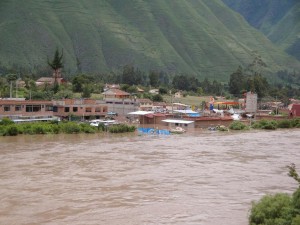Lidar ranging
There’s nothing as seductive as new technology, particularly in the world of archaeology. Some years ago I co-led an expedition that expended an inordinate amount of energy using a thermal imaging camera. We flew over the cloud forest near Machu Picchu to determine the full extent of the nearby site of Llactapata, at a cost of $1000 per hour for the plane, let alone for the camera. Its infra-red vision was supposed to be able to detect the difference in temperature between stone buildings which retain heat, and vegetation which does not. By using it, we hoped to be able to see through the cloud-forest to any ruins below the canopy – the archaeological equivalent of those X-Ray specs sold in schoolboys’ comics to look through women’s skirts, and in the event about as successful.
We ended up going into the forest on foot and looking in the more traditional manner, with machetes, frustration and a great deal of sweat. (The full story is told in Cochineal Red for those interested.)
But an even newer technology has come along that sounds rather more effective: lidar (‘light detection and ranging’). Gamers have used it to create virtual reality sites for some time. Now the husband-and-wife team of Arlen and Diane Chase have adapted it at Caracol in Belize to penetrate the jungle cover and create 3-D images of one of the great cities of the Maya lowlands.
In the process they’ve established that the site was far more extensive than had ever been expected: the city sprawled over some 70 square miles.
Diane Chase was quoted as being ‘blown away’ by the new technology: ‘We believe that lidar will help transform Maya archaeology much in the same way that radiocarbon dating did in the 1950s and interpretations of Maya hieroglyphs did in the 1980s and ’90s.’
Apparently, however, they also emphasized that ‘it would not obviate the need to follow up with traditional mapping to establish “ground truth.” ’ What a terrific phrase – ‘ground truth’. Now that’s something I’ve been searching for my whole life…..


 He was describing his recent work at a site called Huaca el Pueblo, where they uncovered a tomb dating from around 300 to 500 AD. Inside were the remains of four individuals, two men and two women, all in their twenties at the time of death. Working at frantic speed over the space of five weeks to beat the threat from both the humidity and local looters, his team of archaeologists injected alcohol under the mask of ‘the highest status individual’ – who Bourget has called ‘the Lord of Ucupe’ – to loosen it up for removal from his face in the normal way. They then used thin slivers of bamboo to lift it, only to discover another mask underneath, like a Russian doll.
He was describing his recent work at a site called Huaca el Pueblo, where they uncovered a tomb dating from around 300 to 500 AD. Inside were the remains of four individuals, two men and two women, all in their twenties at the time of death. Working at frantic speed over the space of five weeks to beat the threat from both the humidity and local looters, his team of archaeologists injected alcohol under the mask of ‘the highest status individual’ – who Bourget has called ‘the Lord of Ucupe’ – to loosen it up for removal from his face in the normal way. They then used thin slivers of bamboo to lift it, only to discover another mask underneath, like a Russian doll.